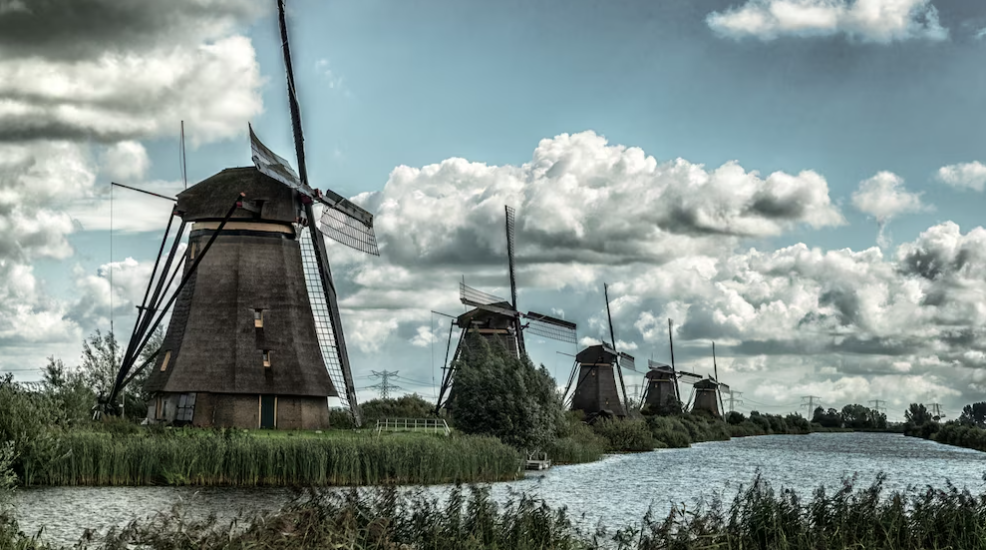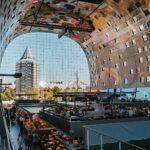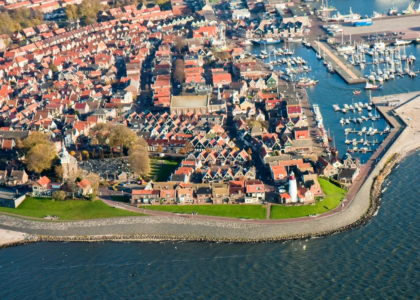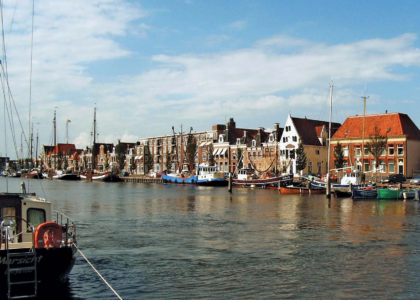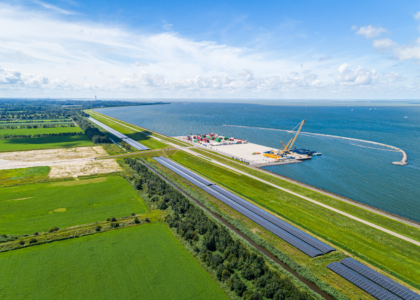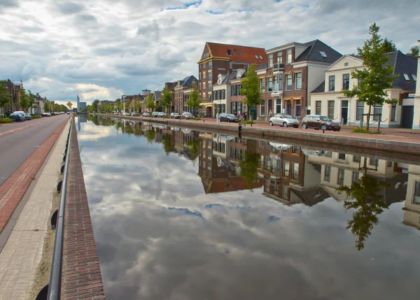Haarlem stands as the premier urban attraction in Noord-Holland, offering a laid-back atmosphere and an abundance of Golden Age architecture. It proudly showcases the province’s finest art gallery and provides easy access to untamed stretches of dunes and beaches in the Nationaal Park Zuid-Kennemerland. Heading northeast from the capital, the charming Zuider Zee ports of Marken, Volendam, and Edam, though touristy, reveal their true charm during the quieter seasons. Further north, Hoorn and Enkhuizen, once flourishing Zuider Zee ports, display their historical prosperity through an array of impressive old structures. Enkhuizen, in particular, captivates with its allure and houses one of the country’s top open-air museums, the Zuiderzeemuseum.
A short train ride north of Amsterdam leads to the Zaanstad conurbation, renowned for its picturesque windmills and canals in Zaanse Schans. Continuing along the railway, the delightful provincial town of Alkmaar hosts the renowned summer cheese market and serves as an excellent base for exploring two protected coastal areas: the Noordhollands Duinreservaat (North Holland Dune Reserve) and the Schoorlse Duinen Nationaalpark. Venturing even further north within the province, you’ll reach the island of Texel, the most easily accessible among the Waddenzee islands. While it may get busy during the summer months, a short walk or bike ride will quickly lead you to peaceful solitude.
Noord-Holland offers a wealth of cultural, natural, and historical treasures, inviting visitors to explore beyond Amsterdam’s boundaries and uncover the province’s hidden gems. From picturesque towns to protected nature reserves, there is something for everyone to enjoy in this captivating region of the Netherlands.
Amsterdam
Start your adventure in North Holland with a visit to Amsterdam, the province’s lively and cosmopolitan capital city. Explore the historic city center, a UNESCO World Heritage site, which is dotted with picturesque canals, magnificent 17th-century merchant houses, and world-renowned museums. Don’t miss the opportunity to visit the Van Gogh Museum, Rijksmuseum, and Anne Frank House. Enjoy a leisurely stroll or a bike ride through Vondelpark, Amsterdam’s largest park, and take a boat tour along the enchanting canals.
Hoorn
Located 15 kilometers north of Edam, the old port of Hoorn, nestled along the Zuider Zee, has been described as an ethereal city from the East, with its enchanting spires and gracefully towering harbor. E.V. Lucas, an English travel writer who visited in 1905, captured the essence of this captivating place. Even today, Hoorn is best experienced when approached from the water. In the seventeenth century, it stood as one of the wealthiest Dutch ports, often referred to as the “trumpet” of the Zuider Zee by the poet Vondel. Hoorn thrived as a hub for the vital Baltic trade and played a significant role in the Dutch colonies. It served as a prominent center for the Dutch East India Company, and it was from Hoorn that The Tasman set sail on its expedition to “discover” Tasmania and New Zealand. In 1616, William Schouten embarked from Hoorn, successfully navigating a passage around South America, and naming its tip “Cape Hoorn” in homage to his hometown. However, the prosperous era came to an end in the early eighteenth century when the harbor became silty, choking off the trade that the town depended on. Hoorn suffered the fate of becoming one of the “dead cities” of the Zuider Zee, a process that was ultimately sealed with the creation of the IJsselmeer in 1932.
Haarlem
Haarlem, situated just a short fifteen-minute train ride away from Amsterdam, offers a refreshing change of pace and atmosphere compared to its bustling neighbor. Once renowned for its cloth production, this charming medium-sized town, with a population of approximately 150,000, welcomes visitors to explore its picturesque center, which can be easily enjoyed within a few hours or during a leisurely overnight stay.
In 1572, Haarlem bravely sided with the Protestant rebels against the Habsburgs, but their decision proved costly when a large Spanish army besieged the town in December of the same year. The siege lasted for eight grueling months until Haarlem eventually surrendered after receiving promises of fair treatment. Tragically, these assurances were quickly broken by the Spanish commander, Frederick of Toledo, who mercilessly massacred over two thousand members of the Protestant garrison. However, Haarlem was recaptured by Dutch forces five years later and went on to flourish during the seventeenth century. The town became a prosperous center, nurturing a vibrant community of painters whose remarkable masterpieces are proudly displayed at the Frans Hals Museum. This exceptional museum is located within the almshouse where Frans Hals spent his final, and arguably most brilliant, years.
Apart from its rich history and artistic heritage, Haarlem also offers convenient access to the stunning coastline. Regular half-hourly train services whisk visitors away on a quick ten-minute journey to the modern resort town of Zandvoort-aan-Zee. Additionally, regular buses connect to Bloemendaal-aan-Zee, a cluster of fast-food establishments situated just north of Haarlem. While these destinations may not immediately capture attention, they are redeemed by their extensive sandy beaches and the untouched stretches of dunes and lagoons that form the captivating landscape of the nearby Nationaal Park de Zuid-Kennemerland. This natural paradise is crisscrossed by an extensive network of footpaths and cycling trails, beckoning exploration and providing a tranquil escape from the bustling urban environment.
The Frans Hals Museum
Situated just a short five-minute stroll south of the Grote Markt, Haarlem’s main square, the Frans Hals Museum stands as the town’s most prominent attraction. It finds its home within the almshouse complex where Frans Hals, the esteemed artist, spent his final years in poverty. The museum’s collection showcases a selection of Hals’ finest works, complemented by a small yet diverse assortment of Dutch paintings spanning from the fifteenth century onward. Each piece is meticulously presented and accompanied by English and Dutch labels. A separate section of the museum features a life-sized replica of a seventeenth-century Haarlem street, providing visitors with a unique glimpse into the city’s past.
Frans Hals Paintings
The collection of Hals’ paintings takes center stage in Room 14, where visitors are greeted by a series of five captivating “Civic Guard” portraits. Hals himself was once a member of the Company of St George, and his self-portrait can be found in the top left-hand corner of the Officers of the Militia Company of St George—a rare depiction of himself. Notable among the works is Johannes Verspronck’s (1600–62) “Regentesses of the Holy Ghost Orphanage,” a masterpiece that rivals even Hals’ own “Regents of St Elizabeth Gasthuis” from 1641 in terms of skill and accomplishment.
However, the most valuable and impressive pieces within the museum are undoubtedly Hals’ renowned twin portraits, “Regents and Regentesses of the Oudemannenhuis.” These paintings depict the individuals responsible for overseeing the almshouse during Hals’ time there, showcasing a collection of austere and self-satisfied faces peering out from the shadows. The reproachful expressions of the women and the men’s slightly more amiable countenances create an eerie, almost ghostly atmosphere. Some critics argue that Hals had lost his touch by the time he created these portraits, but their sinister power and haunting quality suggest quite the opposite.
The Painter with 27 Kinds of Black
Frans Hals (c.1580–1666), born in Antwerp to Flemish refugees who settled in Haarlem in the late 1580s, remains a figure shrouded in mystery. His extant body of work is relatively small, consisting of approximately two hundred paintings, which pales in comparison to the vast number of sketches and studies left behind by his contemporary, Rembrandt. Hals’ exceptional talent lay in his portraiture, demonstrating a deep understanding and empathy for his subjects, capturing fleeting expressions in a way that some argue even surpassed Rembrandt’s abilities. His technique often employed quick, seemingly careless strokes of color, which, when viewed collectively, formed harmonious and vibrant compositions. Hals is perhaps best known for his civic guard portraits—group portraits of militia companies initially formed for defense against the Spanish, which later evolved into social clubs for the aristocracy.
Securing a commission to paint one of these portraits was a prestigious and well-paid privilege, and Hals received his first in 1616. However, the composition of these portraits presented a challenging task, often resulting in dull and flat representations. Hals, with great flair and originality, transformed these group portraits into cohesive and dynamic works of art, skillfully arranging his figures to appear natural and uncontrived. In his later years, Hals’ paintings became darker and more contemplative, adopting lighting techniques akin to Rembrandt’s and exhibiting a progressively somber tone. This gave credence to van Gogh’s observation that “Frans Hals had no fewer than 27 blacks.”
Haarlem’s Hofjes
An ideal way to spend a day in Haarlem is by exploring its hofjes—small, unassuming complexes built in the seventeenth century to provide housing for the elderly and infirm. The most famous and accessible of these hofjes is the one that served as Frans Hals’ home during his final years and now houses the Frans Hals Museum. However, scattered throughout the town, several other hofjes continue to fulfill their original purpose, with some opening their gardens to the public.
Among them, the grandest is the riverside Hofje van Teylers, located a short distance east of the similarly named Teylers Museum, along the bend of the Spaarne at Koudenhorn 64. Unlike many other hofjes, which exude a cozy atmosphere, this Neoclassical building, constructed in 1787, features solid columns and cupolas. To the west, the elegant fifteenth-century tower of the Bakenesserkerk on Vrouwestraat stands tall, marking the nearby Bakenes Hofje at Wijde Appelaarsteeg 11—the oldest hofje in Haarlem and the entire country, founded in 1395. It boasts a delightful enclosed garden. A short five-minute walk away lies the Hofje van Oorschot, situated at the intersection of Kruisstraat and Bartelijorisstraat, dating back to 1769 and boasting its own grandeur. South of this location, the Brouweshofje, tucked away off Botermarkt, offers a peaceful terrace of housing with a courtyard adorned with brightly painted red and white shutters. Close by, the diminutive Hofje van Loo, found on Barrevoetstraat, is equally charming and visible from the road.
Nationaal Park de Zuid-Kennemerland
The untainted woods, dunes, and lagoons of the National Park de Suid-Kennemerland stretch northward from Zandvoort, extending up to the less remarkable industrial town of IJmuiden at the mouth of the Nordzeekanaal. Bus #81 departs from Haarlem bus station every thirty minutes, traversing the national park via the N200 before reaching the coast at the tiny beachside settlement of Bloemendaal-aan-Zee. Along the way, several bus stops provide access to clearly marked hiking and cycling trails that crisscross the park. However, the most recommended option is to disembark at the Koevlak entrance—simply request the driver to let you off there.
Maps of the park are available at the Haarlem tourist office, and at each park entrance, three color-coded hiking routes are clearly indicated. Among them, the most appealing is a 4- to 5-kilometer (approximately 1-hour) walk westward through pine woods and dunes, culminating in a view of the North Sea from the Parnassia café (open from April to November). From there, a 1.5-kilometer stroll leads back to Bloemendaal-aan-Zee, where you can catch bus #81 to return to Haarlem (or, of course, you can reverse the route if desired).
Alkmaar
Known for its traditional cheese market, Alkmaar is a charming city with a rich cultural heritage. Every Friday from April to September, you can witness the spectacle of the Alkmaar Cheese Market, where farmers and traders gather to trade cheese in a traditional manner. Explore the well-preserved historic center, visit the Stedelijk Museum Alkmaar to learn about the city’s history, and take a leisurely boat ride along the canals.
The tradition of Alkmaar’s cheese market dates back to the 1300s, where cheese has been sold on the city’s main square. While it may no longer be a significant commercial enterprise, the kaasmarkt (cheese market) still attracts large crowds. To secure a good view, it’s advisable to arrive early. The ceremonial proceedings commence with buyers inspecting, crumbling, and eventually tasting each cheese, followed by lively negotiations. Once a deal is reached, the cheeses, predominantly golden wheels of Gouda, are carried away on ornate carriers by groups of four porters known as kaasdragers for weighing. Dressed in white trousers and shirts, these porters don distinctive black hats with colored bands, representing the four companies constituting the cheese porters’ guild (green, blue, red, or yellow). According to tradition, payment for the cheeses occurs in the nearby cafés surrounding the square.
The Zuiderzeemuseum
The Zuiderzeemuseum, located just a short stroll from Enkhuizen’s center, offers a captivating experience with its landbound section. Within this area, you’ll find around a dozen rooms dedicated to annual exhibitions that showcase various facets of the Zuider Zee. A highlight of the museum is its remarkable ship hall, where visitors can intimately explore a collection of traditional sailing barges and other remarkable vessels. Among the notable exhibits are an ice-cutting boat from Urk, which once played a crucial role in maintaining open shipping lanes between the island and the mainland. Additionally, you’ll encounter a duck-hunting dinghy equipped with a shotgun, and an array of splendid, fully-rigged sailing vessels boasting exquisite varnished finishes.
Texel
For nature lovers, a trip to the island of Texel is a must. Accessible by ferry from Den Helder, Texel offers pristine beaches, dunes, and a diverse array of wildlife. Explore the island on bike or foot, visit the Ecomare nature center to learn about marine life and seals, and sample local delicacies at one of the cozy seaside restaurants. Don’t forget to catch a beautiful sunset from the island’s western beaches.
Conclusion
North Holland is a region that seamlessly blends history, culture, and natural beauty. From the vibrant streets of Amsterdam to the charming windmills of Zaanse Schans and the tranquil landscapes of Texel, this province offers a wealth of experiences for every traveler. Whether you’re fascinated by art, history, or simply yearning for a tranquil retreat in nature, North Holland will leave you with lasting memories. So pack your bags and embark on an unforgettable journey to this captivating Dutch gem.

